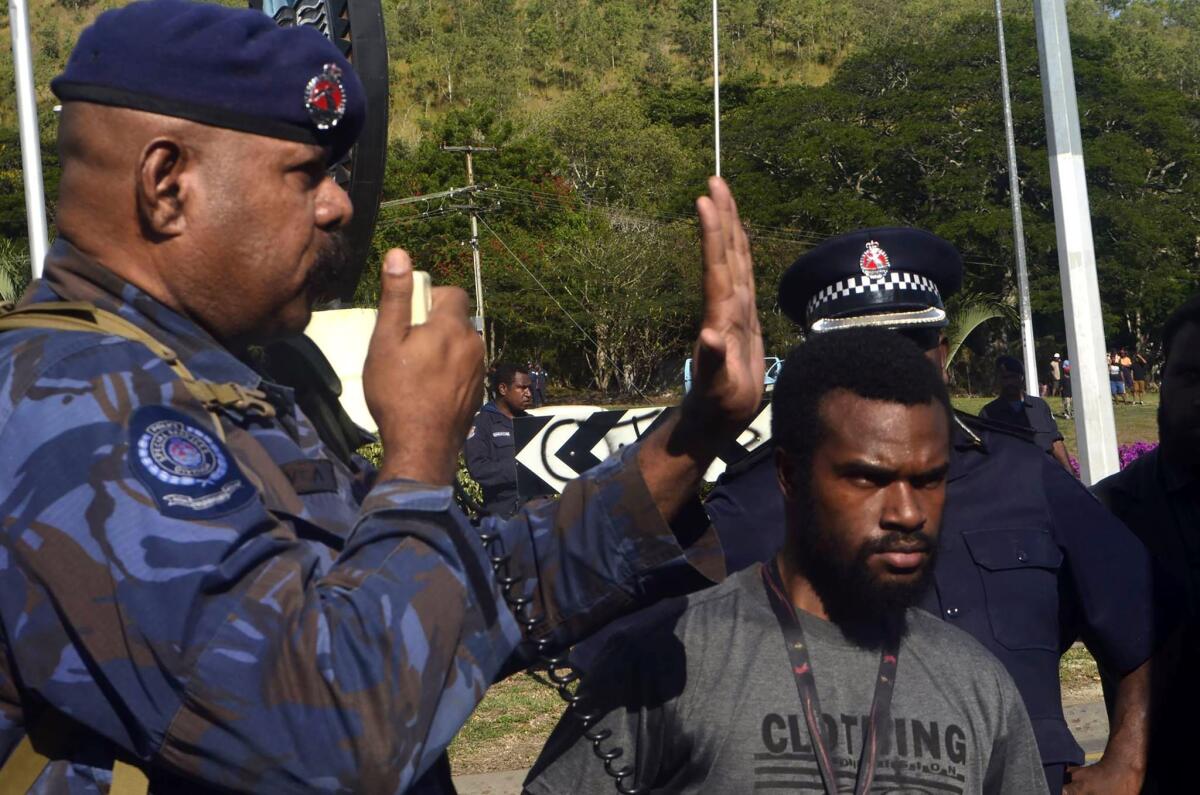23 injured as police and students clash in Papua New Guinea

Reporting from CANBERRA, Australia — Police in Papua New Guinea fired gunshots Wednesday to quell a student protest demanding the prime minister’s resignation, the government said. The country’s police commissioner said nearly two dozen people were injured but denied reports that as many as four people were killed.
Students in the South Pacific nation have been demanding for weeks that Prime Minister Peter O’Neill resign because of reports of corruption and mismanagement.
Australian Foreign Minister Julie Bishop said she had been advised by the Australian embassy that police shot students in Port Moresby, the capital, as hundreds prepared to march from the University of Papua New Guinea to Parliament.
“I know that students have been shot, but we’re still trying to determine whether there have been deaths and how many have been injured,” Bishop told reporters. “We call on all sides to be calm and to de-escalate the tension and certainly call on all sides to respect the peaceful and lawful right to protest.”
Australian Broadcasting Corp. reported that a Papua New Guinea lawmaker told Parliament that four students had been killed and seven wounded.
Joe Duhube, personal assistant to lawmaker Gary Juffa, told the Associated Press that Juffa spoke to students after the shooting and was told “one of the students got killed instantly, and others are in serious and critical condition.”
Papua New Guinea Police Commissioner Gari Baki, however, said no deaths had been reported. In a statement, Baki said 23 people believed to be university students were treated at hospitals after the clash. The head of the emergency ward at Port Moresby General Hospital told police that five of the students were in critical condition, Baki said.
O’Neill issued a statement saying he was told that a small group of students became violent, threw rocks at police and “provoked a response that came in the form of tear gas and warning shots.”
Staycey Yalo, a journalism student at the university, said police did not fire warning shots — they fired directly at the students. Yalo said she and the other protesters encountered a line of police officers blocking them when they tried to march to Parliament. The police demanded they hand over the student president. When the protesters said no, an argument broke out, she said.
“They threw tear gas, and amidst the smoke, they started shooting directly at the students,” Yalo told the AP by telephone. “That’s when we all ran.”
Police in vehicles began chasing after the protesters, with officers firing from their cars at fleeing students, Yalo said. While she was running, a student running alongside her tried to jump over a fence to escape an approaching police car. An officer came up behind the girl and bashed her with his gun, knocking her to the ground before he began kicking her, Yalo said.
“A lot of students, they got hurt — they got really hurt badly,” Yalo said.
The incident caused unrest throughout the area; Yalo said she could still hear gunshots going off outside the house where she was hiding hours after the clash ended.
Waliagai Olewale, a reporter at the local National Broadcasting Corp., said armed police in 20 vehicles clashed with hundreds of students, most of whom eventually were chased back onto the campus late in the morning.
“There was a lot of force that was used on students,” she told the AP. “Students were pushed and shoved. They were beaten up. There were gunshots.”
She said National Broadcasting Corp. reporter Rose Amos lodged an official complaint saying she had been assaulted by police while reporting the clash.
“She was physically assaulted. She was punched in the stomach, thrown to the ground by police,” Olewale said.
ALSO
Clinton is set to make history, but female leaders are nothing new in other parts of the world
What it’s like to live in the world’s fastest growing major economy
Major election losses could threaten ruling party’s grip on Mexican presidency
More to Read
Sign up for Essential California
The most important California stories and recommendations in your inbox every morning.
You may occasionally receive promotional content from the Los Angeles Times.










